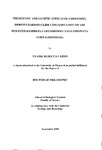Phenotypic and genetic effects of Chernobyl-derived radionuclide contamination on the red-eyed damselfly Erythromma Najas (Odonata, Coenagrionidae)
| dc.contributor.author | Cailes, Claire Rebecca | |
| dc.contributor.other | Faculty of Science and Engineering | en_US |
| dc.date.accessioned | 2011-09-22T12:55:31Z | |
| dc.date.available | 2011-09-22T12:55:31Z | |
| dc.date.issued | 2006 | |
| dc.identifier | Not available | en_US |
| dc.identifier.uri | http://hdl.handle.net/10026.1/602 | |
| dc.description | Merged with duplicate record 10026.1/2280 on 06.20.2017 by CS (TIS) | |
| dc.description.abstract |
The 1986 Chernobyl accident released large amounts of radioactive contamination into the surrounding environment. As a result, the Chernobyl region provides a suitable site for investigations into the effects of ionising radiation on non-human biota. Studies of this type are important in order to establish whether or not current anthropocentric radiation protection guidelines are appropriate for the protection of the wider environment. Despite the presence of many freshwater habitats in the region, there have been few studies investigating the effects of radiation on aquatic invertebrates. In the present study, the effects of Chernobyl-derived radionuclide contamination on the red-eyed damselfly, Erythromma najas (Hansemann 1823) were investigated. This large scale study involved analysis of 720 E. rajas specimens obtained from eight lakes in the Chernobyl region ranging in 137Cs contamination levels from 37000 kBqm-2 to 100 kBqm-2. Estimated external dose rates of ionising radiation ranged from 24 μGyhr-1 to 0.066 μGyhr-I. Fitness of E. najas populations was assessed both phenotypically (by the use of fluctuating asymmetry (FA) techniques) and genetically (by the use of inter simple sequence repeat (ISSR) markers and mitochondrial (mt) DNA sequencing techniques). FA was assessed by the analysis of eight bilateral traits and no relationship between FA and dose rates of ionising radiation was found. Analysis of 61 ISSR bands revealed no evidence of elevated mutation rates in contaminated lakes. This finding was supported by the results of the mtDNA sequencing study which involved sequencing of the COI and COII regions of 80 E. najas specimens. The sequencing study revealed high levels of gene flow between the Chernobyl lakes and no evidence of either an increased mutation rate in contaminated lakes or a population bottleneck. In summary, these studies have revealed no adverse effects of Chernobyl-derived ionising radiation on E. rajas populations. | en_US |
| dc.description.sponsorship | Centre for Ecology and Hydrology | en_US |
| dc.language.iso | en | en_US |
| dc.publisher | University of Plymouth | en_US |
| dc.title | Phenotypic and genetic effects of Chernobyl-derived radionuclide contamination on the red-eyed damselfly Erythromma Najas (Odonata, Coenagrionidae) | en_US |
| dc.type | Thesis | |
| dc.identifier.doi | http://dx.doi.org/10.24382/1515 |
Files in this item
This item appears in the following Collection(s)
-
01 Research Theses Main Collection
Research Theses Main


